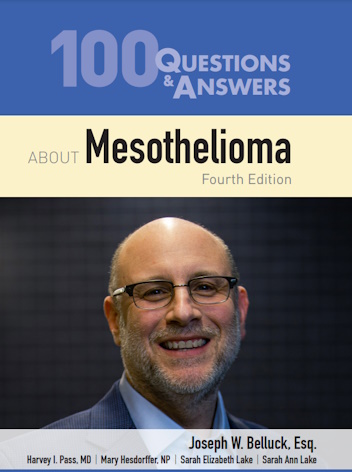Have you or a loved one been diagnosed with mesothelioma?
If you are reading this page, you or someone you love has probably been recently diagnosed with mesothelioma ─ a serious cancer caused by exposure to asbestos. I am sure that you are worried about the challenges of mesothelioma combined with the questions about your treatment options, prognosis, and legal rights … and you might be feeling overwhelmed!
What is mesothelioma?
Mesothelioma is a highly aggressive and painful cancer with symptoms that vary from patient to patient and with the area of the body affected. Its only known cause is Asbestos exposure
Whether you, a loved one, or someone you know has been diagnosed with Mesothelioma, so many questions surrounding compensation, life expectancy, and treatment options come to mind. We help caregivers and patients understand their rights and get the help they need during this difficult time.
We’d like to offer you a free copy of 100 Questions & Answers About Mesothelioma; Co-authored by our very own Joe Belluck.
Risk Factors
Asbestos was used for many decades in a wide variety of industrial, commercial and household products. These include products such as fireproofing materials, valves, pumps, gaskets, boilers, automotive brakes, textile products, electrical products, building materials and more.
Millions of Americans who worked with or in the vicinity of asbestos materials were at risk of exposure. Companies did not warn workers of the risk, and employers did not take proper prevention measures and safety precautions to protect them from inhaling dangerous asbestos fibers in the air. Anyone in an area where asbestos materials were being handled were at risk of being exposed.
Some of the most common occupations at risk include:
- Construction workers
- Electricians
- Engineers
- Factory workers
- Laborers
- Plumbers
- Maintence workers
- Mechanics
- Merchant seamen
- Navy workers
- Powerhouse workers
- Shipyard workers
In addition to the workers themselves, family members may have been exposed to the tiny asbestos fibers that clung to uniforms, clothing, hair and skin. This is known as “take-home” asbestos.
Facts and Information
After a mesothelioma diagnosis, the first thing many families do is research the facts and statistics about the disease. They want to know what caused it, what the treatment options are, and how they can get the help they need.
Some of the facts you should know include:
- The rate of mesothelioma cases are much higher among men than women (likely because of the occupations that were most at risk, employed men).
- Mesothelioma is more commonly diagnosed in white and Hispanic/Latino people that in Afrian Americans or Asian Americans.
- The average age for diagnoses of pleural mesothelioma is 69 years old.
- Many mesothelioma patiens are veterans. Asbestos products were heavily used in all branches of the military, in particular the Navy, putting many service members and civilians at risk.
- Asbestos, the only known cause of mesothelioma, is still not banned in the United States. Even with the safety precautions required today, people remain at risk of exposure.
Frequently Asked Questions
1 How Does Asbestos Cause Mesothelioma?
People who are exposed to asbestos typically inhale tiny fibers that stick in the pleura tissue lining the lungs and coating the chest wall. These asbestos fibers can cause cellular changes, and may cause irritation and inflammation in the pleura for many years before malignant pleural mesothelioma develops. In some cases, people ingest rather than inhale the microscopic asbestos fibers, which can then become lodged in the tissue lining the abdominal cavity and organs. This can eventually cause peritoneal mesothelioma, also known as abdominal mesothelioma. In rare cases, the asbestos fibers make their way to the tissue lining the heart or the testicles, resulting in pericardial or testicular mesothelioma.
2 How Dangerous Is Asbestos?
Asbestos poses a serious health hazard to anyone exposed to it. Since the 1970s, the U.S. government has been working to reduce the use of asbestos-containing materials and has implemented asbestos safety precautions for workers who may come into contact with the deadly material. However, it is still not completely banned in the United States. And there is no safe level of exposure. Asbestos exposure can lead to a number of serious diseases.
3 Is There a Test For Asbestos Exposure?
Although there are no screening tests yet, if you know or suspect that you have been exposed to asbestos, you should talk to your doctor about doing a chest X-ray once a year. X-rays, CT scans, and MRIs can be used to help diagnose mesothelioma and other asbestos-related diseases early. Also, cutting-edge blood tests (such as the MESOMARK blood test) have the potential to improve your chances of early detection.
4 Can Adenocarcinoma Be Caused By Asbestos?
Adenocarcinoma is a cancer that originates in the glandular cells. According to the National Cancer Institute, most cancers of the lung, prostate, colon, pancreas, and breast are adenocarcinomas. Inhalation of asbestos fibers can be a cause of adenocarcinoma in the lungs.
5 What Is The Difference Between Mesothelioma and Asbestos?
Asbestos Asbestos refers to a group of six fibrous minerals that occur naturally in the environment. These minerals have been used in many industrial and household products over the years. Asbestos is considered a dangerous carcinogen, which means it is a cause of cancer. Mesothelioma A type of cancer caused by asbestos exposure.
6 What Is A Mesothelium?
The mesothelium is the membrane that surrounds many of the body’s vital organs. This membrane secretes a lubricating fluid that provides easy movement of the organs within the body. This is where the cancer develops when asbestos is inhaled or ingested. When the mesothelium becomes cancerous, it is called mesothelioma. There can be multiple forms of the cancer when it affects the mesothelium. The form is determined by the location in which the tumor begins, known as its origin site, and the type of cells that the tumor invades, known as its histological subtype. Each type may require a different treatment.
7 Can Smoking Cause Mesothelioma?
Asbestos is the only known cause of mesothelioma. If you are a smoker who has been diagnosed, your doctor will urge you to quit immediately.
8 Why is malignant pleural mesothelioma the most common type of mesothelioma?
Most people are exposed to asbestos when fibers from asbestos-containing materials become airborne. This could happen when cutting, sanding, drilling, filing, or otherwise disturbing these dangerous materials. In the past, some workers also were exposed to raw asbestos, which was mixed with other materials to form products such as asbestos cement. Airborne asbestos fibers could easily drift across an entire worksite, putting everyone in the vicinity at risk, not just those who were working directly with the material. This widespread exposure risk makes pleural the most common type of the disease.
9 Can mesothelioma be inherited?
No, malignant mesothelioma cannot be inherited, and it is not contagious. However, family members could have been exposed to asbestos secondhand (known as take-home asbestos) when those who worked with the material accidentally brought fibers home on clothing or uniforms. Secondhand exposure to asbestos can cause mesothelioma. There may be some genetic factors in the development of this asbestos cancer.
Lung Cancer Vs. Mesothelioma
10 Is mesothelioma the same as lung cancer?
Mesothelioma is a cancer that attacks the mesothelium tissue that lines the lungs, chest cavity, and other organs in the body. Exposure to asbestos can cause both types of cancer, but it is the only known cause of malignant mesothelioma.
Asbestosis Vs. Mesothelioma
11 What is asbestosis disease?
Asbestosis disease is a chronic lung condition that is caused by inhaling asbestos fibers. The asbestos fibers lodge in tiny sacs in the lungs, known as alveoli. Symptoms of asbestosis include shortness of breath, tightness and pain in the chest, chronic cough, loss of appetite, weight loss, and clubbing of fingers and toes. Treatment can include use of an oxygen tube or mask, pulmonary rehabilitation exercises, or a lung transplant in extreme cases.
12 Are asbestosis and mesothelioma the same?
No. Although both of these diseases, along with lung cancer, are associated with exposure to asbestos, they are not the same. Asbestosis is a chronic lung disease, not a cancer. It is caused by inhalation of asbestos fibers, which can get stuck in the small sacs in the lungs. Having asbestosis can increase a patient’s chances for developing asbestos-related lung cancer. Malignant mesothelioma is a cancer. It affects the mesothelium tissue, which lines the lungs and chest wall, as well as the abdominal cavity, heart, and testicles. Malignant mesothelioma is caused by the inhalation or ingestion of asbestos fibers, which lodge in the mesothelium tissue.
100 Questions & Answers About Mesothelioma
100 Questions & Answers About Mesothelioma is committed to providing treatment information for those diagnosed with mesothelioma. This book offers help – whether you’re a newly diagnosed mesothelioma patient, a survivor, a friend, a relative, or a caregiver. It is written from a medical perspective and gives you authoritative, practical answers to your questions about treatment options, post-treatment quality of life, sources of support, legal options, and much more.
Get Your FREE Copy
Get a FREE copy of Top 100 Questions & Answers About Mesothelioma mailed to you.
As a special thank you, you’ll get instant access to a chapter from the book.

It’s time to get you information that you can trust.
When faced with a terrible diagnosis, it’s only natural that you want answers. Unfortunately, there is a lot of inaccurate information about mesothelioma, and you are likely overwhelmed with questions, fears, and conflicting information. We are confident that you will find the insights and resources in this book helpful, and that it will provide you with the answers that you need to understand mesothelioma.
